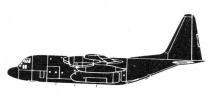Incident Overview

Description
A Bombardier E-11A operated by the US Air Force crashed in the Deh Yak district in Afghanistan, killing both pilots. The aircraft, from 430th EECS, was outfitted with a Battlefield Airborne Communications Node (BACN) and operated as a communications-relay platform out of Kandahar Airport, Afghanistan. At the time of the accident the aircraft operated on a combat sortie as well as a Mission Qualification Training for the first officer. Takeoff occurred at 11:05 local time. The flight proceeded to the assigned orbit using standard departure/climb procedures. The crew assumed a circular orbit just west of Kabul at 42,000 feet altitude at about 11:36. At 12:50, the crew requested and was cleared by ATC to climb from 42,000 feet altitude to 43,000 feet altitude. The engine revolutions per minute (RPMs) advanced and the crew initiated the climb with the autopilot, gaining about 300 feet. At 12:50:52, a fan blade broke free and separated from the N1 first-stage turbofan of the left engine, causing major damage and resulting in the immediate shutdown of that engine by the Electronic Engine Controller (EEC), a subsystem of the Full Authority Digital Engine Controller (FADEC). This was accompanied by a bang. Simultaneous with the bang, the CVR recording stopped. Within one to two seconds after the initial event, the autothrottles disengaged automatically. The autopilot was engaged and it remained engaged. Bank angles remained essentially constant, consistent with a circular orbit, and the aircraft descended from an altitude of 42,300 feet to 41,000 feet. Ten seconds after the catastrophic left engine failure, the crew retarded both throttles to just less than halfway (14 degrees; total throttle range is from 0 40 degrees) for one second, then slightly advancing the left throttle separately (26 degrees) for one second, then retarding it to align with the right throttle (both at 16 degrees) for one second, and finally splitting the throttles to advance the left throttle (to 31 degrees) while retarding the right to idle (0 degrees). Nine seconds after moving the right throttle to idle, the crew placed the right engine run switch to off, shutting down the right engine. Finally, at 12:51:19, the left throttle was advanced to full power (40 degrees), briefly cycled then brought to idle. At 12:51:23, both throttles were advanced from idle to full power. It is likely the crews first actions, including the shutdown, were hastened by a sense of urgency due to aircraft vibrations and other auditory/sensory cues, reinforced by the startle response. The crew announced to Kabul ATC that they had lost both engines and that they intended to proceed to Kandahar, which was well outside the E-11A glide capabilities. This intent suggests that the crew was confident of airstarting one or both engines. While the crew would have waited, in accordance with the checklist, to 30,000 feet to attempt an airstart, an airstart of the right engine should have been successful, whether accomplished with windmilling airspeed or with the assistance of the APU. However, airstarts of the left engine would have failed due to the original damage. There is no DFDR data to definitively confirm whether an engine airstart attempt was made. At 13:03:30, the crew announced to ATC that they were going to land at FOB Sharana. The aircraft continued to glide without engine power and was not able to reach Sharana. At approximately 13:09, the aircraft impacted the ground approximately 21 NM (39 km) short of Sharana, on a heading of roughly 140 degrees, consistent with a direct flight path towards Sharana. The terrain was unpopulated, largely flat, and covered in snow. The wings show the slats out and the flaps appear to be extended, suggesting that the aircraft had been configured for, and presumably slowed for, landing. It is likely that the crew attempted to make a forced landing. While the terrain was largely flat, the aircraft impacted berms and ditches, roughly estimated between 3-6 feet high. Weather at Sharana was reported to have 1000 foot ceilings, and pilot testimony confirms approximately 1000 foot ceilings in the vicinity of the accident site. Accordingly, the crew may have had less than a minute to maneuver after exiting the clouds and seeing the terrain. It appears that while the aircraft touched down, it impacted a smaller berm almost immediately, then more completely impacted the ground and skidded to a halt in approximately 340 meters. During this time the wings were ripped from the aircraft, and subsequently much of the cockpit and cabin were destroyed by fire. The Accident Investigation Board (AIB) President found by a preponderance of the evidence that the cause of the mishap was the MC’s error in analyzing which engine had catastrophically failed (left engine). This error resulted in the MC’s decision to shutdown the operable right engine creating a dual engine out emergency. The AIB President also found by a preponderance of the evidence that the MC’s failure to airstart the right engine and their decision to recover the MA to KAF substantially contributed to the mishap.
Source of Information
https://www.wsj.com/articles/u-s-recovers-two-killed-in-air-force-crash-in-taliban-territory-11580232907, https://www.airforcetimes.com/news/your-air-force/2021/01/21/broken-fan-blade-shutdown-of-wrong-engine-led-to-fatal-e-11-crash-in-afghanistan-report-says/, https://www.militarytimes.com/news/your-military/2020/01/27/us-army-investigating-plane-crash-in-taliban-held-area/, https://aerossurance.com/air-accidents-incidents/usaf-e11a-global-express-psmicr/, https://www.acc.af.mil/News/Article-Display/Article/2478327/e-11a-accident-investigation-board-report-released/, https://www.afjag.af.mil/Portals/77/AIB-Reports/2020/27JAN20%20ACC%20Bagram%20Airfield%20E-11%20AIB%20Report.pdfhttps://www.wsj.com/articles/u-s-recovers-two-killed-in-air-force-crash-in-taliban-territory-11580232907, https://www.airforcetimes.com/news/your-air-force/2021/01/21/broken-fan-blade-shutdown-of-wrong-engine-led-to-fatal-e-11-crash-in-afghanistan-report-says/, https://www.militarytimes.com/news/your-military/2020/01/27/us-army-investigating-plane-crash-in-taliban-held-area/, https://aerossurance.com/air-accidents-incidents/usaf-e11a-global-express-psmicr/, https://www.acc.af.mil/News/Article-Display/Article/2478327/e-11a-accident-investigation-board-report-released/, https://www.afjag.af.mil/Portals/77/AIB-Reports/2020/27JAN20%20ACC%20Bagram%20Airfield%20E-11%20AIB%20Report.pdfPrimary Cause
UnknownUnknownShare on:



